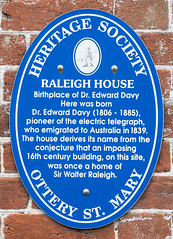Dr Edward Davy
Dr Edward Davy
(1806-1885)
Commemorated on 1 plaque
Raleigh House Birthplace of Dr. Edward Davy Here was born Dr. Edward Davy (1806 - 1885), pioneer of the electric telegraph, who emigrated to Australia in 1839. The house dervices its name from the conjecture that an imposing 16th century building, on this site, was once a home of Sire Walter Raleigh.
Mill Street, Ottery St Mary, United Kingdom where they was

